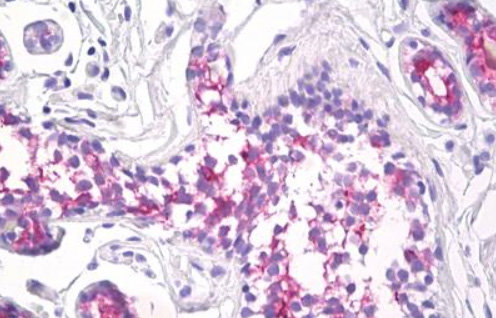EMA (MUC1) Mouse Monoclonal Antibody [Clone ID: 175C5]
CAT#: AM32800PU-N
EMA (MUC1) mouse monoclonal antibody, clone 175C5, Purified
Need it in bulk or conjugated?
Get a free quote
CNY 5,186.00
货期*
5周
规格
Specifications
| Product Data | |
| Clone Name | 175C5 |
| Applications | ELISA, EM, FC, IF, IHC, IP, WB |
| Recommend Dilution | ELISA. Western Blot. Immunofluorescence. Immunoprecipitation. Electron Microscopy. Flow Cytometry. Immunohistochemistry on Frozen Sections. Immunohistochemistry on Paraffin Sections (10 µg/ml). |
| Reactivity | Human |
| Host | Mouse |
| Clonality | Monoclonal |
| Immunogen | Human mammary carcinoma cell line (ZR-75-1). |
| Specificity | Shows a high preference for breast carcinomas relative to normal breast epithelium. The antibdy reacts with a carcinoma-associated antigen in both adenocarcinomas and squamous cellcarcinomas of different origins. |
| Formulation | PBS State: Purified State: Liquid purified IgG fraction Preservative: 0.09% Sodium Azide |
| Concentration | lot specific |
| Conjugation | Unconjugated |
| Storage Condition | Store undiluted at 2-8°C for one month or (in aliquots) at -20°C for longer. |
| Gene Name | mucin 1, cell surface associated |
| Database Link | |
| Background | This gene is a member of the mucin family and encodes a membrane bound, glycosylated phosphoprotein. The protein is anchored to the apical surface of many epithelia by a transmembrane domain, with the degree of glycosylation varying with cell type. It also includes a 20 aa variable number tandem repeat (VNTR) domain, with the number of repeats varying from 20 to 120 in different individuals. Mucin 1, cell surface associated (MUC-1) or polymorphic epithelial mucin (PEM) is a mucin encoded by the MUC1 gene in humans. MUC-1 is a glycoprotein with extensive O-linked glycosylation of its extracellular domain. Mucins line the apical surface of epithelial cells in the lungs, stomach, intestines, eyes and several other organs. The protein serves a protective function by binding to pathogens and also functions in a cell signaling capacity. Overexpression, aberrant intracellular localization, and changes in glycosylation of this protein have been associated with colon, breast, ovarian, lung and pancreatic cancers. |
| Synonyms | MUC-1, PEMT, Episialin, EMA, H23AG, PUM, DF3, CA 15-3 |
| Reference Data | |
Documents
| Product Manuals |
| FAQs |
| SDS |
Resources
| 抗体相关资料 |
Customer
Reviews
Loading...


 United States
United States
 Germany
Germany
 Japan
Japan
 United Kingdom
United Kingdom
 China
China

